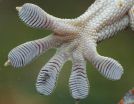(Press-News.org) Harvard researchers have succeeded in creating quantum switches that can be turned on and off using a single photon, a technological achievement that could pave the way for the creation of highly secure quantum networks.
Built from single atoms, the first-of-their-kind switches could one day be networked via fiber optic cables to form the backbone of a "quantum Internet" that allows for perfectly secure communications, said Professor of Physics Mikhail Lukin, who led a team consisting of graduate student Jeff Thompson and post-doctoral fellow Tobias Tiecke to construct the new system. Their research is detailed in a recently published paper in Nature.
"From a technical standpoint, it's a remarkable accomplishment," Lukin said of the new advance. "Conceptually, the idea is very simple – push the conventional light switch to its ultimate limit. What we've done here is to use a single atom as a switch that, depending on its state, can open or close the flow of photons…and it can be turned "on" and "off" using a single photon."
Though the switches could be used to build a quantum computer, Lukin said it's unlikely the technology will show up in the average desktop computer.
Where they will be used, he said, is in creating fiber optical networks that use quantum cryptography, a method for encrypting communications using the laws of quantum mechanics to allow for perfectly secure communication. Such systems make it impossible to intercept and read messages sent over the network, because the very act of measuring a quantum object changes it, leaving behind telltale signs of the spying.
"It's unlikely everyone would need this type of technology," he said. "But there are some realistic applications that could someday have transformative impact on our society. At present, we are limited to using quantum cryptography over relatively short distances – tens of kilometers. Based on the new advance, we may eventually be able to extend the range of quantum cryptography to thousands of kilometers."
Importantly, Tiecke said, their system is highly scalable – and could one day allow for the fabrication of thousands of such switches in a single device.
"What we've really done is taken ideas that people have been exploring, and still are exploring, in macroscopic systems where the light bounces back and forth on two centimeter-sized mirrors to interact with an atom – we've taken that and shrunk it down," said Thompson. "For two decades, researchers have been working on coupling two or three of these macroscopic systems and create a simple network, but it's very easy for us to create three or four, or 10,000 of these optical circuits. What the present paper shows is, at least technologically, the way forward."
That is one way, Lukin believes, for quantum systems to make the same transition conventional computers made decades ago – from vacuum tubes to integrated circuits.
"Conventional computers were initially built using vacuum tubes, and people eventually developed integrated circuits used in modern computers," he said. "Where quantum systems stand today, the best systems are still analogous to vacuum tubes – they typically use vacuum chambers to isolate and hold single atoms using electromagnetic fields.
"But it's very clear, if we want to scale these systems up, we have to think about using integrated circuits," he continued. "What Jeff and Tobias have done is create a hybrid system. We take atoms in vacuum chambers and combine them with integrated circuits."
Though fabricated in a similar way traditional computer chips are made, the integrated circuits built by Thompson and Tiecke don't run on electricity, but on light.
The chips use nano-photonic technology – essentially the ability to create "wiring" that can channel and control the pathway of light – to build optical circuits which can then be connected to fiber optic cables.
After placing the optical circuits in a vacuum chamber, researchers used "optical tweezers" – precisely focused lasers – to capture a single atom and cool it to a fraction above absolute zero temperature. They then move the atom to within a few hundred nanometers of the chip.
Simply bringing the two parts together, however, isn't enough.
To create quantum switches that may one day be at the heart of quantum networks, they bombard the atom with microwaves and lasers, causing it to enter a quantum superposition state – meaning it can occupy multiple quantum states, corresponding to "on" and "off" states of the switch, at once.
"For this to work, the atom switch must be prepared in this special superposition state ," Lukin explained. "This superposition state is extremely fragile – so fragile that when a single photon hits it, it actually changes its phase. That change of phase is what allows it to act like a valve, and be turned on or off."
While it's unlikely the switches will become standard equipment for personal computers, Lukin said they could appear in prototype quantum networks in as little as a decade.
"There are other systems that are more sophisticated in terms of building a quantum computer," Thompson said. "But the key advantage to what's demonstrated in this paper is the single atom switch is very tightly coupled to light, and specifically to light in optical fibers."
INFORMATION:
Flipping the switch
Physicists design quantum switches which can be activated by single photons
2014-04-18
ELSE PRESS RELEASES FROM THIS DATE:
MRI, on a molecular scale
2014-04-18
For decades, scientists have used techniques like X-ray crystallography and nuclear magnetic resonance imaging (NMR) to gain invaluable insight into the atomic structure of molecules, but such efforts have long been hampered by the fact that they demand large quantities of a specific molecule and often in ordered and crystalized form to be effective – making it all but impossible to peer into the structure of most molecules.
Harvard researchers, however, say those problems may soon be a thing of the past.
A team of scientists, led by Professor of Physics and of Applied ...
Stanford researchers rethink 'natural' habitat for wildlife
2014-04-18
Protecting wildlife while feeding a world population predicted to reach 9 billion by 2050 will require a holistic approach to conservation that considers human-altered landscapes such as farmland, according to Stanford researchers.
Wildlife and the natural habitat that supports it might be an increasingly scarce commodity in a world where at least three-quarters of the land surface is directly affected by humans and the rest is vulnerable to human-caused impacts such as climate change. But what if altered agricultural landscapes could play vital roles in nurturing wildlife ...
Finding turns neuroanatomy on its head
2014-04-18
Harvard neuroscientists have made a discovery that turns 160 years of neuroanatomy on its head.
Myelin, the electrical insulating material long known to be essential for the fast transmission of impulses along the axons of nerve cells, is not as ubiquitous as thought, according to a new work lead by Professor Paola Arlotta of the Harvard Stem Cell Institute (HSCI) and the University's Department of Stem Cell and Regenerative Biology, in collaboration with Professor Jeff Lichtman, of Harvard's Department of Molecular and Cellular Biology.
"Myelin is a relatively recent ...
Researchers question published no-till soil organic carbon sequestration rates
2014-04-18
URBANA, Ill. For the past 20 years, researchers have published soil organic carbon sequestration rates. Many of the research findings have suggested that soil organic carbon can be sequestered by simply switching from moldboard or conventional tillage systems to no-till systems. However, there is a growing body of research with evidence that no-till systems in corn and soybean rotations without cover crops, small grains, and forages may not be increasing soil organic carbon stocks at the published rates.
"Some studies have shown that both moldboard and no-till systems ...
Sun emits a mid-level solar flare
2014-04-18
The sun emitted a mid-level solar flare, peaking at 9:03 a.m. EDT on April 18, 2014, and NASA's Solar Dynamics Observatory captured images of the event. Solar flares are powerful bursts of radiation. Harmful radiation from a flare cannot pass through Earth's atmosphere to physically affect humans on the ground, however -- when intense enough -- they can disturb the atmosphere in the layer where GPS and communications signals travel.
To see how this event may impact Earth, please visit NOAA's Space Weather Prediction Center at http://spaceweather.gov, the U.S. government's ...
Researchers find 3-million-year-old landscape beneath Greenland ice sheet
2014-04-18
Glaciers and ice sheets are commonly thought to work like a belt sander. As they move over the land they scrape off everything — vegetation, soil and even the top layer of bedrock. So a team of university scientists and a NASA colleague were greatly surprised to discover an ancient tundra landscape preserved under the Greenland Ice Sheet, below two miles of ice.
"We found organic soil that has been frozen to the bottom of the ice sheet for 2.7 million years," said University of Vermont geologist and lead author Paul Bierman. The finding provides strong evidence that the ...
Religious music brings benefit to seniors' mental health
2014-04-18
A new article published online in The Gerontologist reports that among older Christians, listening to religious music is associated with a decrease in anxiety about death and increases in life satisfaction, self-esteem, and sense of control over their lives. In particular, listening to gospel music is associated with a decrease in anxiety about death and an increase in sense of control.
These associations are similar for blacks and whites, women and men, and individuals of both low- and high-socioeconomic status.
The article, titled "Listening to Religious Music and ...
Ancient DNA offers clues to how barnyard chickens came to be
2014-04-18
Durham, NC — Ancient DNA adds a twist to the story of how barnyard chickens came to be, finds a study to be published April 21 in the journal Proceedings of the National Academy of Sciences.
Analyzing DNA from the bones of chickens that lived 200-2300 years ago in Europe, researchers report that just a few hundred years ago domestic chickens may have looked far different from the chickens we know today.
The results suggest that some of the traits we associate with modern domestic chickens -- such as their yellowish skin -- only became widespread in the last 500 years, ...
Plants with dormant seeds give rise to more species
2014-04-18
Durham, NC — Seeds that sprout as soon as they're planted may be good news for a garden. But wild plants need to be more careful. In the wild, a plant whose seeds sprouted at the first
warm spell or rainy day would risk disaster. More than just an insurance policy against late frosts or unexpected dry spells, it turns out that seed dormancy has long-term advantages too: Plants whose seeds put off sprouting until conditions are more certain give rise to more species, finds in a team of researchers working at the National Evolutionary Synthesis Center in North Carolina.
When ...
Gecko-like adhesives now useful for real world surfaces
2014-04-18
AMHERST, Mass. – The ability to stick objects to a wide range of surfaces such as drywall, wood, metal and glass with a single adhesive has been the elusive goal of many research teams across the world, but now a team of University of Massachusetts Amherst inventors describe a new, more versatile version of their invention, Geckskin, that can adhere strongly to a wider range of surfaces, yet releases easily, like a gecko's feet.
"Imagine sticking your tablet on a wall to watch your favorite movie and then moving it to a new location when you want, without the need for ...
LAST 30 PRESS RELEASES:
The vast majority of US rivers lack any protections from human activities, new research finds
Ultrasound-responsive in situ antigen "nanocatchers" open a new paradigm for personalized tumor immunotherapy
Environmental “superbugs” in our rivers and soils: new one health review warns of growing antimicrobial resistance crisis
Triple threat in greenhouse farming: how heavy metals, microplastics, and antibiotic resistance genes unite to challenge sustainable food production
Earthworms turn manure into a powerful tool against antibiotic resistance
AI turns water into an early warning network for hidden biological pollutants
Hidden hotspots on “green” plastics: biodegradable and conventional plastics shape very different antibiotic resistance risks in river microbiomes
Engineered biochar enzyme system clears toxic phenolic acids and restores pepper seed germination in continuous cropping soils
Retail therapy fail? Online shopping linked to stress, says study
How well-meaning allies can increase stress for marginalized people
Commercially viable biomanufacturing: designer yeast turns sugar into lucrative chemical 3-HP
Control valve discovered in gut’s plumbing system
George Mason University leads phase 2 clinical trial for pill to help maintain weight loss after GLP-1s
Hop to it: research from Shedd Aquarium tracks conch movement to set new conservation guidance
Weight loss drugs and bariatric surgery improve the body’s fat ‘balance:’ study
The Age of Fishes began with mass death
TB harnesses part of immune defense system to cause infection
Important new source of oxidation in the atmosphere found
A tug-of-war explains a decades-old question about how bacteria swim
Strengthened immune defense against cancer
Engineering the development of the pancreas
The Journal of Nuclear Medicine ahead-of-print tip sheet: Jan. 9, 2026
Mount Sinai researchers help create largest immune cell atlas of bone marrow in multiple myeloma patients
Why it is so hard to get started on an unpleasant task: Scientists identify a “motivation brake”
Body composition changes after bariatric surgery or treatment with GLP-1 receptor agonists
Targeted regulation of abortion providers laws and pregnancies conceived through fertility treatment
Press registration is now open for the 2026 ACMG Annual Clinical Genetics Meeting
Understanding sex-based differences and the role of bone morphogenetic protein signaling in Alzheimer’s disease
Breakthrough in thin-film electrolytes pushes solid oxide fuel cells forward
Clues from the past reveal the West Antarctic Ice Sheet’s vulnerability to warming
[Press-News.org] Flipping the switchPhysicists design quantum switches which can be activated by single photons





